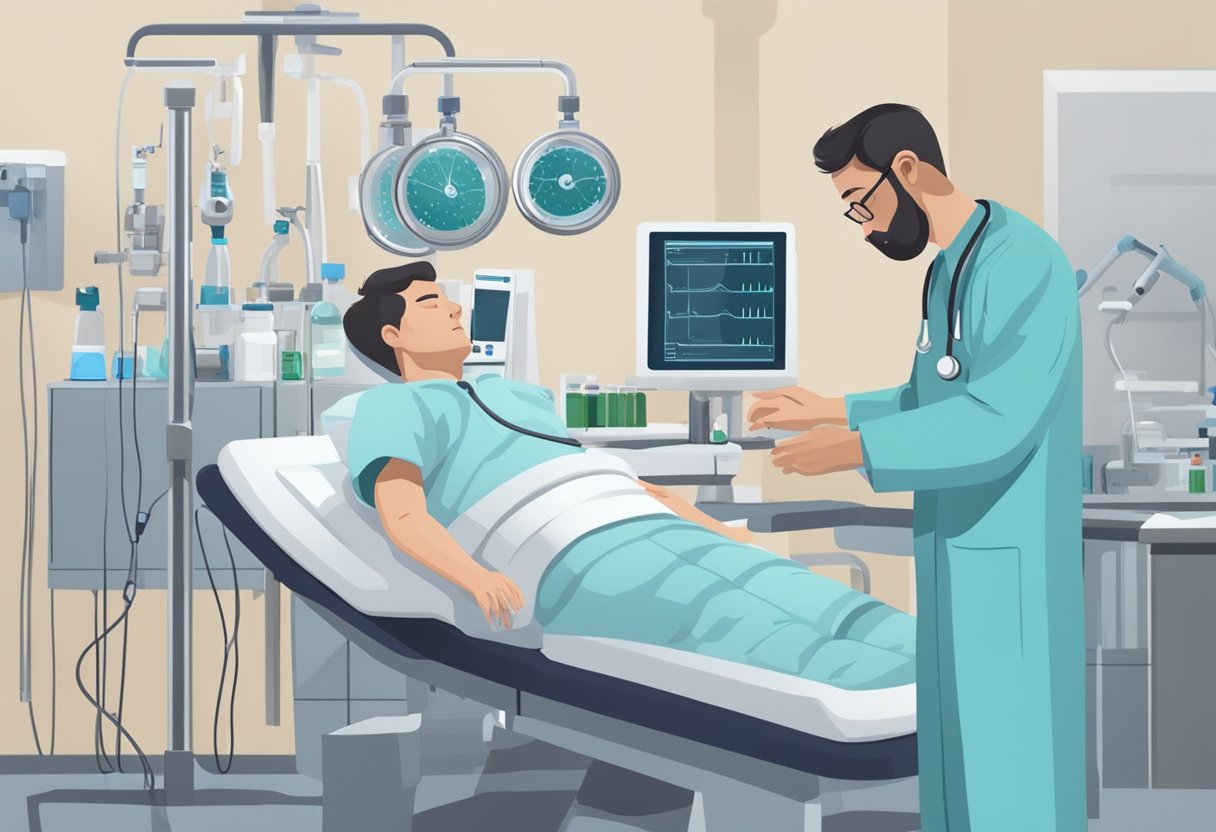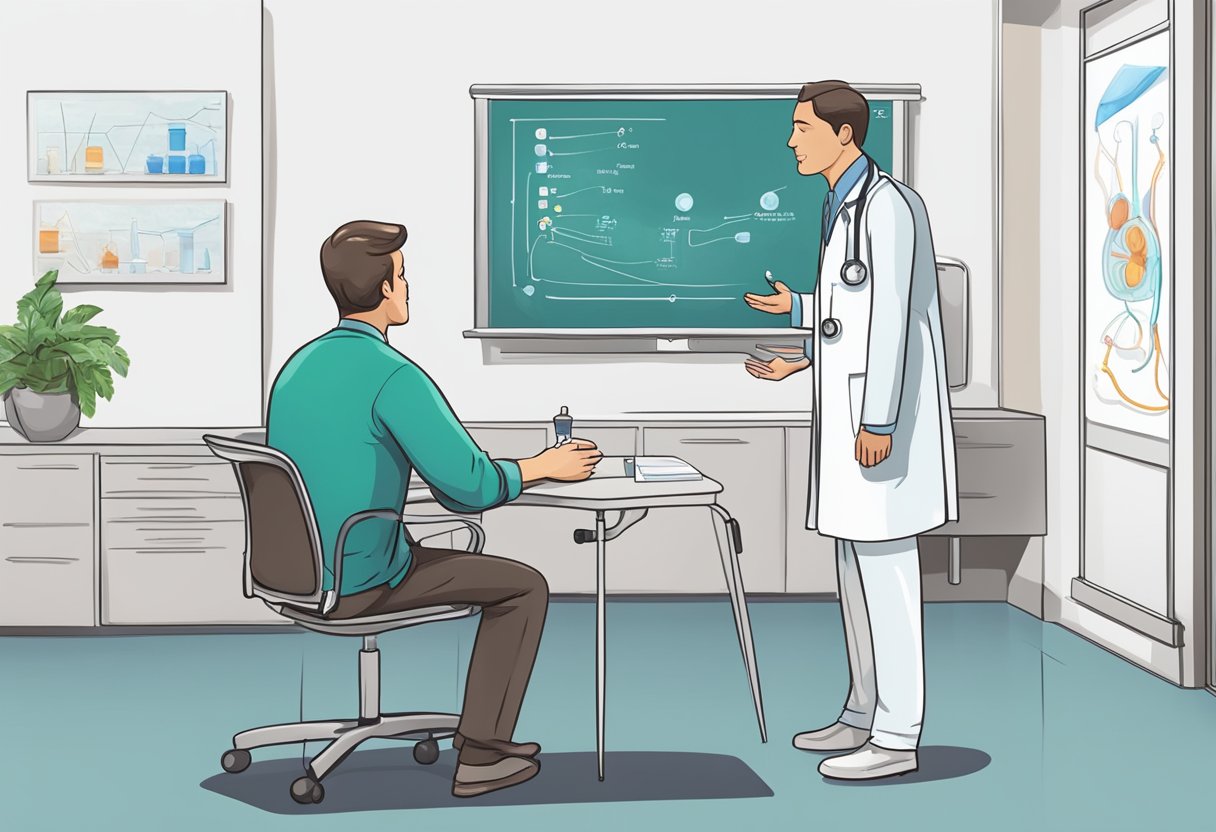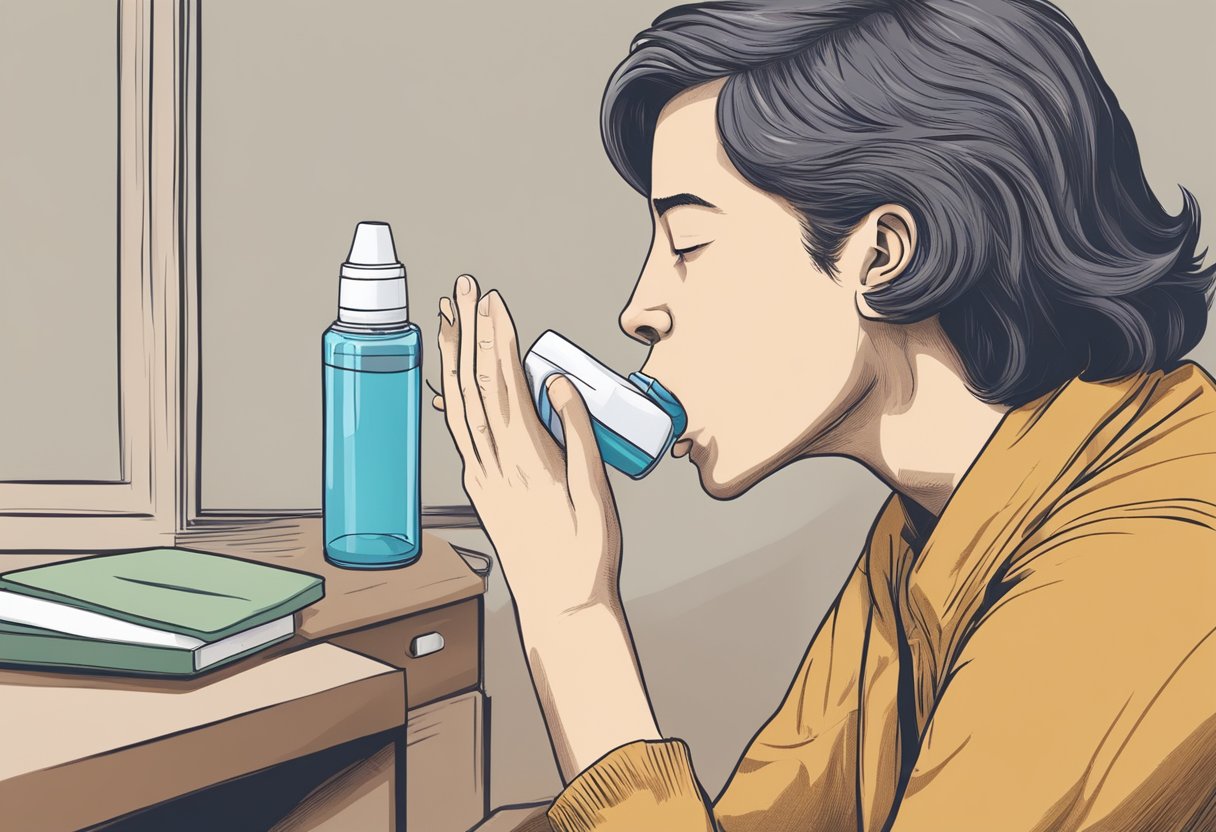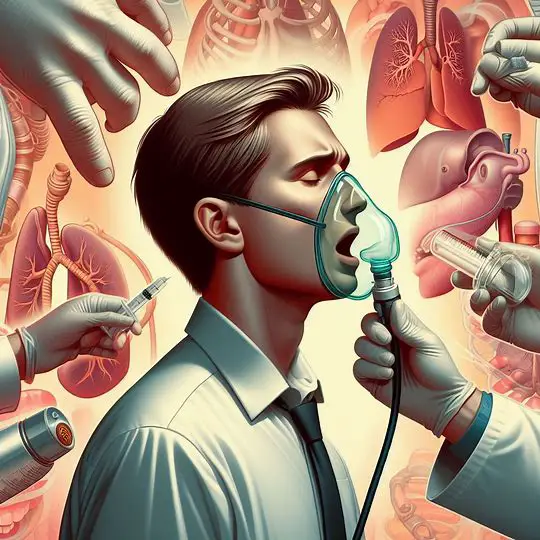Explore the common triggers of shortness of breath, understand effective treatments available, and learn how to recognize when professional medical attention is needed.
Table of Contents
Introduction – Shortness of breath
Shortness of breath, medically known as dyspnea, is a common symptom that can be caused by various conditions affecting the respiratory or cardiovascular system and other systems of the body. It is the subjective feeling of having difficulty breathing or not being able to get enough air. People may experience shortness of breath suddenly for a short period or over the long term, depending on the underlying cause.

Understanding what causes shortness of breath is crucial for diagnosis and treatment. Certain medical conditions, such as asthma, chronic obstructive pulmonary disease (COPD), heart failure, and anemia, can lead to the development of dyspnea. Factors such as allergies, high altitudes, or obesity can also cause breathing difficulties. Diagnosing the cause of dyspnea often involves various procedures and tests, from physical examinations to imaging tests and blood work.
Key Takeaways
- Dyspnea is the subjective feeling of breathing difficulty and can be acute or chronic.
- A range of medical conditions, including respiratory and cardiac problems, can lead to shortness of breath.
- Diagnosis and treatment of dyspnea require a thorough medical assessment and may involve multiple tests and procedures.
Understanding Shortness of Breath

Shortness of breath, medically termed dyspnea, is a common symptom that can result from a variety of causes ranging from benign to serious medical conditions. This section will focus on defining the term, exploring potential causes, and discussing common symptoms associated with dyspnea.
Defining Dyspnea
Dyspnea is the sensation of having difficulty breathing or experiencing breathlessness. It is a subjective experience that varies in intensity and can be affected by numerous factors.
Causes of Shortness of Breath
Shortness of breath can stem from multiple issues, most often related to cardiac or pulmonary conditions. Causes include but are not limited to:
- Asthma: Characterized by inflamed airways and difficulty breathing.
- Pulmonary embolism: A blood clot in the lungs obstructing blood flow.
- COPD: Including emphysema, where airflow is blocked due to lung damage.
- Cardiac tamponade: Excess fluid around the heart.
Other causes can be related to anxiety disorders, anemia, or extreme temperatures.
Key Causes and References:
| Cause | Description | Source URL |
|---|---|---|
| Anaphylaxis | A severe allergic reaction is causing swelling and hindering breathing. | Mayo Clinic |
| COPD | Group of diseases that block airflow, including emphysema. | Cleveland Clinic |
| Cardiac tamponade | Excess fluid around the heart causing difficulty breathing. | Verywell Health |
| Asthma | Airway inflammation and difficulty breathing. | WebMD |
Common Associated Symptoms
Symptoms accompanying shortness of breath commonly include:
- Cough: Often indicative of underlying respiratory conditions.
- Fever: Can suggest an infectious cause.
- Chest pain: Sometimes related to cardiac issues.
- Trouble breathing: Including a tightening of the chest or feeling as if air supply is insufficient.
Noteworthy Symptoms and Associations:
| Symptom | Often Associated With | Notes |
|---|---|---|
| Cough | Respiratory infections, Asthma | Indicates irritation or obstruction in the airways. |
| Fever | Infection | May accompany dyspnea when shortness of breath is due to infectious disease. |
| Chest pain | Cardiac conditions | Can be a sign of serious heart issues. |
| Trouble breathing | Stress, Anxiety disorders | Sometimes non-physiological factors play a role. |
In short, dyspnea is a complex symptom with varied causes and is frequently accompanied by other symptoms such as cough, fever, and chest pain. Understanding the underlying etiology is essential for appropriate management.
Medical Conditions Related to Breathlessness

Breathlessness, also known as dyspnea, can be symptomatic of various underlying medical conditions, primarily affecting the respiratory or cardiovascular systems. This section explores the medical conditions often associated with the experience of breathlessness.
Respiratory System Disorders
Asthma and chronic obstructive pulmonary disease (COPD) are two prevalent respiratory disorders that lead to shortness of breath. Asthma is characterized by inflamed airways and spasms, leading to difficulty breathing, while COPD—a term that includes emphysema and chronic bronchitis—results in obstructed airflow from the lungs. Conditions like pulmonary embolism (a blood clot in the lungs), lung cancer, and pneumonia (an infection that inflames the air sacs in one or both lungs) also contribute significantly to breathlessness.
- Asthma: Inflammation and airway spasms causing breathlessness.
- COPD: Chronic bronchitis and emphysema causing blocked airflow.
- Pulmonary Embolism: Blood clot blocking a lung artery.
- Lung Cancer: Tumors in the lungs obstructing breathing.
- Pneumonia: Infection causing lung inflammation and fluid build-up.
Source: Mayo Clinic, Cleveland Clinic
Cardiovascular Complications
Heart attack, marked by the death of heart muscle due to lost blood supply, and heart failure, where the heart doesn’t pump blood as well as it should, can manifest as breathlessness. Pulmonary hypertension and cardiomyopathy are other cardiovascular ailments linked with the symptom. Pulmonary hypertension involves high blood pressure in the lung arteries, making it difficult for the heart to pump blood through the lungs. At the same time, cardiomyopathy refers to diseases of the heart muscle that can lead to heart failure.
- Heart Attack: Loss of blood supply to heart muscle.
- Heart Failure: Inefficient blood pumping from the heart.
- Pulmonary Hypertension: High blood pressure in lung arteries.
- Cardiomyopathy: Disease of the heart muscle.
Source: Mayo Clinic
Other Health Issues
Obesity can cause breathlessness due to extra weight exerting pressure on the diaphragm and lungs. Anemia, a condition marked by a lack of healthy red blood cells, can contribute to a feeling of being out of breath since the body’s tissues are receiving less oxygen. Allergic reactions, which may cause airways to constrict, and respiratory infections are also notable contributors. Conditions such as sarcoidosis, an inflammatory disease that affects multiple organs, primarily the lungs, can also be associated with shortness of breath.
- Obesity: Pressure on lungs and diaphragm.
- Anemia: Reduced oxygen supply to tissues.
- Allergic Reactions: Constricted airways.
- Respiratory Infections: Breathing difficulty due to infection.
- Sarcoidosis: Inflammatory disease that often affects the lungs.
Source: WebMD, Verywell Health
| Condition | Description | Keyword |
|---|---|---|
| Asthma | Airway inflammation and spasms | Respiratory Disorder |
| Heart Attack | Death of heart muscle | Cardiovascular Complication |
| Obesity | Extra weight stressing the respiratory system | Health Issue |
| Pneumonia | Infection causing lung inflammation | Respiratory Infection |
| Pulmonary Embolism | Artery blockage in lungs by blood clot | Lung Condition |
| Sarcoidosis | Multi-organ inflammatory disease | Lung Disease |
Diagnostic Procedures and Tests

Diagnosing shortness of breath involves a combination of clinical assessments, imaging, monitoring techniques, and laboratory examinations to determine the underlying causes. Healthcare providers methodically perform these tests to measure oxygen levels, evaluate the heart and lungs, and identify systemic issues.
Initial Clinical Assessment
In the initial clinical assessment, healthcare providers conduct a detailed medical history and physical examination. They listen to the patient’s lungs, check the heart rate, and look for signs of respiratory distress. The severity and duration of shortness of breath are critical in guiding the diagnostic pathway.
Imaging and Monitoring
Imaging tests, such as a chest X-ray, are crucial for visualizing the lungs and heart. They can detect abnormalities like pneumonia, heart failure, or lung obstructions. An electrocardiogram (ECG) is another essential test that monitors heart function and can indicate if a cardiac issue contributes to respiratory symptoms.
Laboratory Examinations
Blood tests play a significant role in diagnosing shortness of breath. They can reveal infections, anemia, or other systemic conditions. Measurement of oxygen level in the blood is done through pulse oximetry or arterial blood gas tests, providing insight into the severity of the respiratory issue.
| Test Type | Purpose | Source |
|---|---|---|
| Clinical Assessment | To examine physical signs and take medical history. | American Lung Association |
| Imaging (Chest X-ray) | To visualize lung and heart structures. | Mayo Clinic |
| Monitoring (Electrocardiogram) | To assess heart rhythms and function. | StatPearls |
| Laboratory (Blood Test) | To detect infections, anemia, and measure oxygen levels. | AFP |
| Key Finding | Related Keywords |
|---|---|
| Measurement of oxygen level indicates respiratory efficiency. | oxygen level, pulse oximetry |
| Electrocardiogram reveals cardiac involvement in dyspnea. | electrocardiogram, heart function |
| Blood tests can uncover systemic conditions causing dyspnea. | blood test, infections, anemia |
Treatment and Management Options

Effective management of shortness of breath depends on the underlying cause. With a range of options, from medications and therapies to lifestyle modifications, individuals can find relief and improve their quality of life.
Medications and Therapies
Bronchodilators and steroids are often prescribed to open airways and reduce inflammation in respiratory conditions such as asthma or COPD. Antibiotics might be necessary to tackle the underlying bacterial cause of infections. Patients may also require supplemental oxygen to ensure adequate blood saturation.
Lifestyle Changes and Home Remedies
Non-pharmacological interventions can play a significant role in managing shortness of breath. Avoiding tobacco smoke and reducing exposure to pollutants can markedly improve air quality and lung function. Managing allergies and stress through relaxation techniques and controlled breathing may alleviate symptoms.
| Lifestyle Change | Benefit |
|---|---|
| Quitting Smoking | Reduces lung irritation and damage |
| Stress Management | Lowers breathing rate and eases dyspnea |
| Air Purifiers | Improves indoor air quality |
Emergency Interventions
In acute cases, such as severe asthma attacks or anaphylaxis, emergency medical treatment is necessary. Rapid administration of medications through an inhaler or intravenous therapy can be life-saving. High-flow oxygen or mechanical ventilation may be required to maintain respiratory function.
| Emergency Intervention | Description |
|---|---|
| Inhaler Use | Quick relief of acute symptoms |
| Oxygen Therapy | Immediate support for oxygenation |
Relevant Studies and Further Reading:
| Topic | Source URL |
|---|---|
| Medication Treatments | Verywell Health |
| Home Remedies | Healthline |
| Emergency Care | Cleveland Clinic |
Prevention and Long-Term Care

Preventing shortness of breath involves addressing factors contributing to the condition and implementing long-term strategies for respiratory health. By managing risks and maintaining routine health checks, individuals can reduce the occurrence of this symptom.
Risk Factor Mitigation
- Exercise: Regular, moderately intense exercise can improve overall lung function and reduce the risk of obesity, a known contributor to respiratory issues.
- Smoking: Avoiding tobacco use or seeking assistance to quit smoking is crucial as it is a leading cause of lung diseases, according to the American Lung Association.
- Lifestyle Changes: Simple lifestyle adjustments, such as mindful breathing techniques, can alleviate anxiety-related breathing problems.
- High Altitude: Acclimatization to high-altitude environments can help prevent altitude-induced shortness of breath.
Regular Monitoring and Health Maintenance
- Healthcare Providers: Regular visits to healthcare providers allow for the early detection of potential lung concerns and the promotion of lung health.
- CDC Guidelines: Following the Centers for Disease Control and Prevention guidance for vaccinations and health practices can prevent infections that may lead to shortness of breath.
| Key Point | Recommendation | Source |
|---|---|---|
| Obesity | Engage in weight management and exercise | CDC Obesity Prevention |
| Smoking | Quit tobacco products with healthcare provider support | American Lung Association |
| Anxiety | Adopt relaxation and breathing exercises | Not available |
| Exercise | Follow a consistent and sustainable exercise routine | Not available |
In summary, managing preventable risk factors and maintaining regular health routines are paramount in preventing and caring for shortness of breath. Proactive measures supported by the American Lung Association and CDC effectively mitigate lung disease risks.
Frequently Asked Questions
Shortness of breath can stem from a variety of conditions. Recognizing the symptoms and understanding the underlying causes is vital for treatment and management.
How can shortness of breath be treated?
Treatment for shortness of breath depends on the underlying cause. For immediate relief, sitting upright and using supplemental oxygen may help. Long-term treatments might include medication or therapy, as advised by healthcare providers. For further treatment options, visit Verywell Health.
What are the symptoms associated with shortness of breath?
Symptoms that often accompany shortness of breath include a feeling of suffocation, chest tightness, and the inability to breathe deeply. It can occur suddenly or build up gradually. Mayo Clinic provides a comprehensive list of related symptoms.
What conditions can cause shortness of breath to occur intermittently?
Intermittent shortness of breath may result from asthma, stress, anxiety, or high altitude. Chronic Obstructive Pulmonary Disease (COPD) can also cause episodes of shortness of breath. To understand more about COPD-related shortness of breath, read the information provided by Cleveland Clinic.
Can shortness of breath and fatigue be related symptoms?
Yes, shortness of breath and fatigue often appear together, especially in conditions affecting the heart or lungs. They can also be a sign of overexertion, poor sleep quality, or psychological conditions such as anxiety. Explore this relationship further at Medical News Today.
Why do I experience shortness of breath during nighttime?
Nighttime shortness of breath may occur due to sleep apnea, heart failure, or acid reflux. The supine position often exacerbates the feeling of breathlessness. WebMD provides details on possible causes and treatments.
How can one determine if their shortness of breath relates to cardiac issues?
Shortness of breath related to heart problems often occurs during activity and may accompany symptoms like chest pain or palpitations. A healthcare provider might suggest an echocardiogram or stress test to determine if the heart is the source. For more on cardiac evaluation, consider the expertise of Mayo Clinic.




